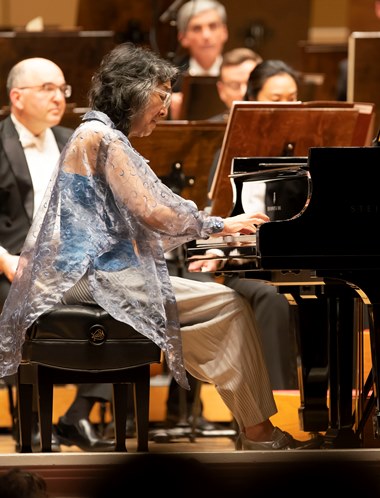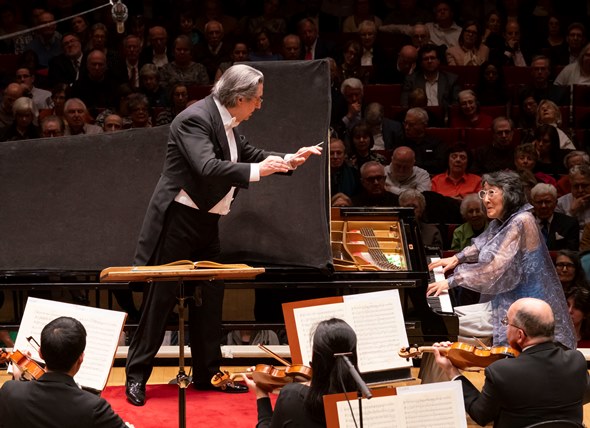With Orchestra Hall again open for business, Uchida and Kissin electrify capacity houses

Riccardo Muti and Mitsuko Uchida shared the applause after their performance of Mozart’s Piano Concerto in D minor at Orchestra Hall. (Concert photos by Todd Rosenberg)
Review: Chicago Symphony conducted by Riccardo Muti; Mitsuko Uchida, piano. Recital by Evgeny Kissin, piano. At Orchestra Hall.
By Lawrence B. Johnson
The piano was at center stage, and all seemed right with the world in the happy, normal – actually, quite thrilling – aftermath of the Chicago Symphony Orchestra’s protracted strike. Many an anticipated concert got wiped out by the strike, but the timing favored two pianists who happen to be favorites at Orchestra Hall: Mitsuko Uchida, who gave a memorable performance of Mozart’s Piano Concerto No. 20 in D minor with the CSO under Riccardo Muti (May 9-11), and Evgeny Kissin, who offered a typically thoughtful, brilliant and roaringly received recital May 12.
At age 70, Uchida still plays with the intensity, eloquence and virtuosity that have marked her artistic lifetime before the public. What a pleasure it was to hear her focusing wholly on the piano and not splitting her attention between the keyboard and the duties of conductor, as she did in almost annual, and almost always semi-satisfying, Mozart concerto appearances with the CSO. When she can devote her musicianship to the keyboard, Uchida’s Mozart soars to the ethereal realm of the Schubert sonatas she has so often and gloriously explored in recitals at Orchestra Hall.
To the shadowy, introspective D minor Piano Concerto, Uchida brought not just an aura of tragedy without words but a spirituality that seemed to transcend the darkness of the music under her hands. This was transfiguring art, sculpted as much as played, at once probing and aspiring. Owing to the dark key it shares with Mozart’s opera “Don Giovanni,” the 20th Piano Concerto is sometimes relegated almost casually to the domain of the somber and bleak, not to say demonic. Uchida’s luminous performance reminded one of the psychological complexity of the work, its emotional layering and, not least, its sheer lyrical magnificence.
Technically, expressively, musically, it was an engagement with Mozart to beggar description. In the concerto’s animated outer movements, Uchida summoned all the power one might have asked and yet preserved the work’s intrinsic linearity with a finely gauged touch and an unfailing ear for its poetry – the inherent lyric drama so urgently evocative of Mozart opera. Her effortless turn through the slow movement was lit from within, singing and radiant.
If Uchida could give herself entirely to the demands of the piano part, the CSO – indeed, the performance generally – benefited from the concentrated authority of the opera master on the podium. Muti was Uchida’s ideal colleague, not accompanist but co-equal collaborator, as sensitive as the pianist to the work’s expressive depths and theatrical inflections. And the orchestra glistened: softly, brightly, as the moment required.
Muti prefaced the concerto with one of Mozart’s most perfect diamonds, the Overture to “The Marriage of Figaro,” some four minutes of music that Muti and company burnished here with a breathtaking mix of elegance, vitality and wit.
The concert’s second half was all Stravinsky, suites from two ballets – a punchy, piquant account of a comparative rarity, “The Fairy’s Kiss,” a lean product of the composer’s neo-classic period, and an opulent turn through bits of “The Firebird,” which seemed more brilliant than compelling. So accomplished a musician of the theater as Muti might have done better to present the full “Firebird” ballet and let the lesser “Fairy’s Kiss” go.
Just as Uchida was greeted by a full house of cheering admirers, Kissin looked out on an auditorium crammed to the rafters and flowing across the stage behind him. He surely delivered what his Chicago fans have come to expect – starting with three Chopin Nocturnes that unfolded as evocative serenades, leisurely and probing and lustrous.
The magnum opus of Kissin’s program was Schumann’s Sonata No. 3 in F minor, the so-called “Concerto Without Orchestra,” a tag contrived by his publisher and none of Schumann’s doing. But one could see immediately, in Kissin’s heroic assault on the virtuosic opening movement, how an enterprising marketer might have hit upon that concerto-sans sobriquet.
Though the original work was a grand epic in five movements with two scherzos, that same publisher pared the F minor Sonata back to three movements without either scherzo. But one of the scherzos was ultimately restored, and in that form the work has come down to us. Like the surviving scherzo, the outer movements are fashioned from prodigious handfuls of notes that make outsized virtuosic demands of the sort later associated with Rachmaninoff. The densely packed finale is marked “as fast as possible.”
Remarkably, Kissin illuminated Schumann’s imposing score with transparent facility, absolute articulation even in its most fearsome passages. The work seems to progress from grand to grander, and Kissin took it all in as if it were a spring ride in a fast car with the top down and the wind in his hair. His audience stormed its appreciation.
In high contrast came eight Debussy Preludes drawn from Books I and 2. And now Kissin, the titan who could stand toe to toe with the towering Schumann sonata, shifted into a display of consummate finesse and delicate tone painting in ultra-familiar pieces like “The Girl With the Flaxen Hair,” “The Sunken Cathedral” and “Interrupted Serenade.”
At the end came the delicious urbanity of Scriabin’s Sonata No. 4 in F-sharp, whose two movements Kissin dispatched with languorous indulgence and ripping pyrotechnics.
But did I say the end? No Kissin recital ends with the printed program, and the crowd at Orchestra Hall knew full well that more was coming. Amid clamorous applause, Kissin tossed off encores of Schumann’s “Träumerei,” Debussy’s “Golliwog’s Cakewalk,” Chopin’s Grand valse brillante” and the pianist’s own “Dodecaphonic Tango.” The rhythmic clapping was still going strong when Kissin finally declared enough. He knew, everybody knew, he’d be back.





